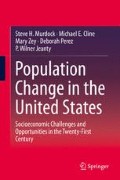Abstract
Demographic and socioeconomic change effects school enrollment and related costs. Nearly 50 million children were enrolled in public elementary and secondary education in the United States in 2010 and more than 15 million in public colleges and universities. Change in enrollment will be due to minority students such that by 2060, of the 59.2 million enrolled in elementary and secondary schools, only 32.1% will be nonHispanic White and, of the 17.9 million enrolled in public colleges and universities, only 41.7% will be nonHispanic White (compared to 52.4 and 62.6% respectively in 2010). By comparison 38.5% of those enrolled in elementary and secondary schools and 27.3% of those enrolled in colleges and universities will be Hispanic. Costs for elementary and secondary education will increase from $604 Billion in 2010 to nearly $723 billion per year in 2060. College costs are projected to increase from $305 to nearly $361 billion. Costs of college attendance have increased while public support has lagged such that the percent of students with financial need unmet by household resources (and thus requiring outside financial assistance) is increasing. By 2060, 55.4% of nonHispanic Blacks, 48.9% of Hispanics, 54.9% of nonHispanic Asian and Others and 43.8% of nonHispanic Whites will have unmet financial need of $10,000 or more per year. Higher levels of education are of increasing importance to economic success but costs for college attendance will present increasing obstacles to college attendance for all students, and particularly for minority students.
Access this chapter
Tax calculation will be finalised at checkout
Purchases are for personal use only
References
Bare, J. (1997). The impact of the baby boom echo on U.S. public school enrollments. Issue brief NCES 98–039. Washington, DC: National Center for Education Statistics.
Davis, J. W., & Bauman, K. (2011). School enrollment in the United States: 2008. Population characteristics. Current population reports P20-564 (June). Washington, DC: U.S. Census Bureau.
Farmer, T. A. (2011). The new Hispanic majority: How Texas public schools are foreshadowing national trends. Paper presented at the annual meeting of the Pennsylvania educational research association (Philadelphia, PA, 6 Oct 2011).
Fry, R., & Gonzales, F. (2008). One-in-five and growing fast: A profile of Hispanic public school students. Washington, DC: Pew Hispanic Center.
U.S. Census Bureau. (2002). 2000 census of population and housing, summary file 3. Washington, DC: U.S. Census Bureau.
U.S. Census Bureau. (2003). 2000 census of population and housing, summary file 4. Washington, DC: U.S. Census Bureau.
U.S. Census Bureau. (2011a). 2006–2010 American community survey. Washington, DC: U.S. Census Bureau.
U.S. Census Bureau. (2011b). 2006–2010 American community survey selected population tables. Washington, DC: U.S. Census Bureau.
U.S. Census Bureau. (2011c). 2010 census summary file 1. Washington, DC: U.S. Census Bureau.
U.S. Census Bureau. (2011d). 2010 census summary file 2. Washington, DC: U.S. Census Bureau.
U.S. Census Bureau. (2012). 2012 national population projections. Washington, DC: U.S. Census Bureau.
U.S. Census Bureau, & U.S. Bureau of Labor Statistics. (2008). 2007 current population survey: Survey of income and program participation. Washington, DC: U.S. Bureau of Labor Statistics and U.S. Census Bureau.
U.S. Census Bureau, & U.S. Bureau of Labor Statistics. (2011). 2010 current population survey: Annual demographic survey. Washington, DC: U.S. Bureau of Labor Statistics and U.S. Census Bureau.
U.S. Department of Education, National Center for Education Statistics. (1982–2011). Common core of data: State nonfiscal survey of public elementary and secondary education, 1981–1982 through 2009–2010. Washington, DC: U.S. Department of Education, National Center for Education Statistics.
U.S. Department of Education, National Center for Education Statistics. (1986–1999). Common core of data: Integrated postsecondary education data system (IPEDS), fall enrollment survey (IPEDS-EF:86–99). Washington, DC: U.S. Department of Education, National Center for Education Statistics.
U.S. Department of Education, National Center for Education Statistics. (1997–2012). Common core of data (CCD): State nonfiscal survey of public elementary/secondary education, 1996–97 through 2010–11. Washington, DC: U.S. Department of Education, National Center for Education Statistics.
U.S. Department of Education, National Center for Education Statistics. (2002–2012). Common core of data: Integrated postsecondary education data system (IPEDS), Spring 2001 through Spring 2011, enrollment component. Washington, DC: U.S. Department of Education, National Center for Education Statistics.
U.S. Department of Education, National Center for Education Statistics. (2002–2013a). Common core of data: Integrated postsecondary education data system, Spring 2001 through Spring 2012, finance component, and unpublished tabulations. Washington, DC: U.S. Department of Education, National Center for Education Statistics.
U.S. Department of Education, National Center for Education Statistics. (2002–2013b). Integrated postsecondary education data system Spring 2001 through Spring 2012, finance component, and unpublished tabulations. Washington, DC: U.S. Department of Education, National Center for Education Statistics.
U.S. Department of Education, & National Center for Education Statistics. (2011). Common core of data (CCD): National public elementary and secondary enrollment by race/ethnicity model, 1994–2010. Washington, DC: U.S. Department of Education, National Center for Education Statistics.
U.S. Department of Education, & National Center for Education Statistics. (2012). Common core of data (CCD): Integrated postsecondary education data system (IPEDS), Spring 2011, enrollment component, higher education general information survey. Washington, DC: U.S. Department of Education, National Center for Education Statistics.
U.S. Department of Education, & National Center for Education Statistics. (2013). Common core of data (CCD): 2007–08 national postsecondary student aid studies (NPSAS:08). Washington, DC: U.S. Dept. of Education, National Center for Education Statistics. August 2013 Revision.
Author information
Authors and Affiliations
Rights and permissions
Copyright information
© 2015 Springer Science+Business Media Dordrecht
About this chapter
Cite this chapter
Murdock, S.H., Cline, M.E., Zey, M., Perez, D., Jeanty, P.W. (2015). Impacts of Future Demographic Change on Education in the United States. In: Population Change in the United States. Springer, Dordrecht. https://doi.org/10.1007/978-94-017-7288-4_5
Download citation
DOI: https://doi.org/10.1007/978-94-017-7288-4_5
Publisher Name: Springer, Dordrecht
Print ISBN: 978-94-017-7287-7
Online ISBN: 978-94-017-7288-4
eBook Packages: Humanities, Social Sciences and LawSocial Sciences (R0)

